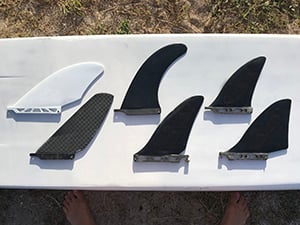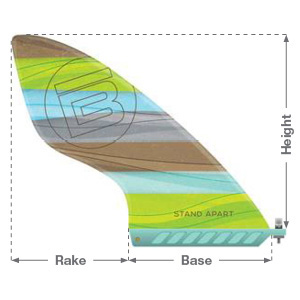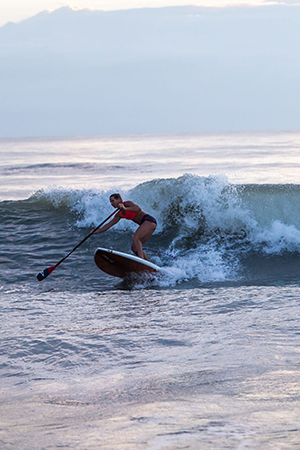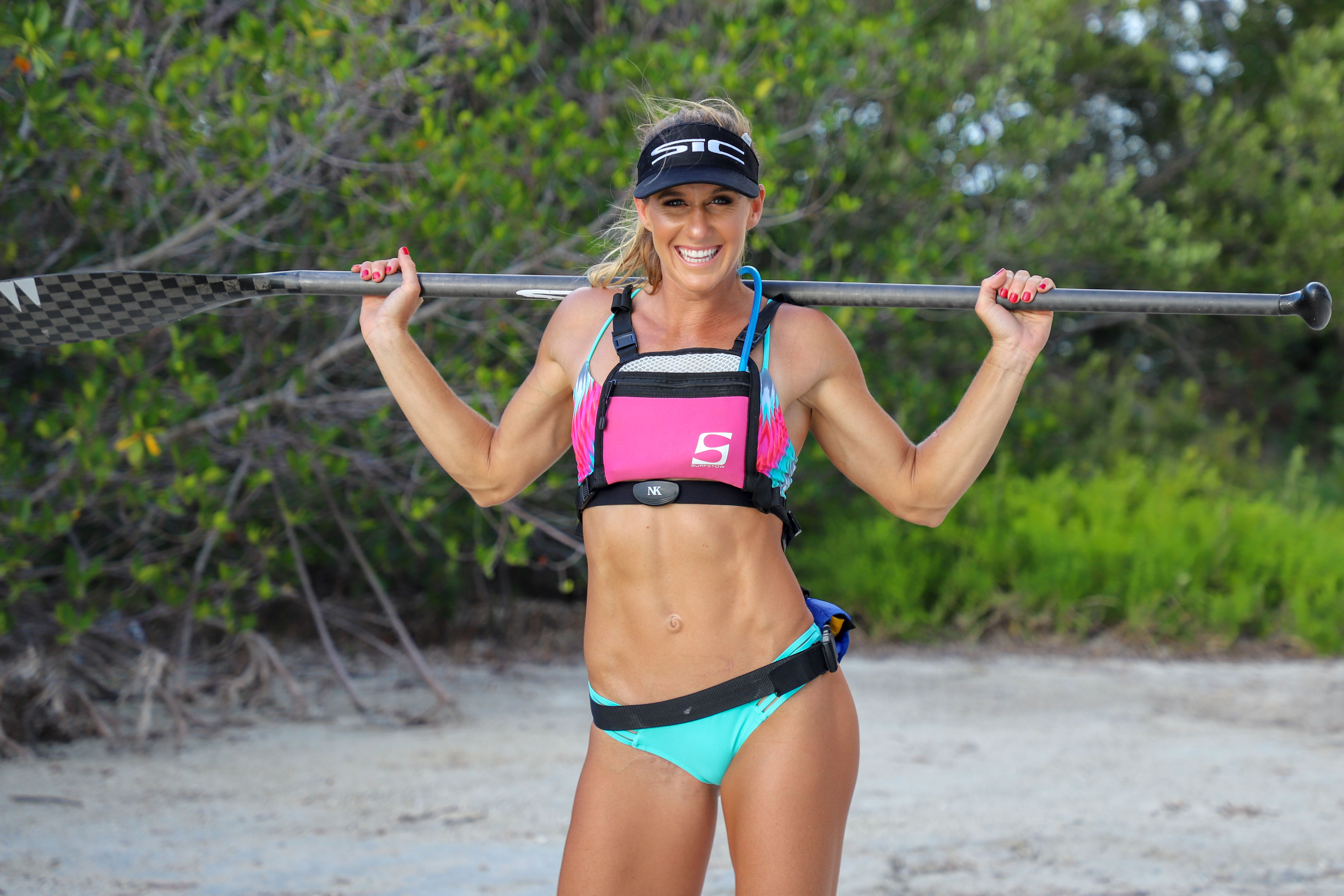
There are a wide variety of fin designs.
Fin shape and material affect board performance.
When selecting a fin, you should consider its shape and the material of which it is made. Fin shape is described according to the fin’s height, base, surface area and rake. Fins can be made of plastic, fiberglass, carbon fiber or other materials. Following are some definitions and a short discussion of how each affects board performance.
Fin Height: How tall the fin is from top to bottom.
Generally speaking, the height of the fin is what gives a board its stability while paddling. The deeper the fin penetrates the water, the more stable the board is going to feel. Greater height results in less rocking from side to side. However, the deeper the fin is in the water, the more drag it creates. Drag reduces board speed.
Fin Base: The length of the bottom edge of the fin, closest to the board.
The base of the fin is what determines how well a board will track. Tracking is how much the board zig zags from side to side when you paddle. Ideally, we want to paddle our boards in as straight a line as possible. A wider fin base results in better tracking. However, a wider fin base will also decrease the maneuverability of the board and cause it to turn more slowly. This is great for long, straight paddles and flat water conditions. This is not ideal for ocean paddling, buoy turns, or surfing.

A fin's surface area, base length, height and rake all affect board performance.
Fin Surface Area: The total area of the fin measured in square inches.
The effect of surface area on board performance varies with fin design. More surface area closer to the board, at the base of the fin, means increased tracking and can even help increase the glide of the board. However, greater surface area at the base also decreases a board’s maneuverability by increasing the turning radius. Think: “More distance per stroke, but slower turns.”
More surface area near the tip of the fin will increase a board’s stability but will increase drag and also decrease the maneuverability of the board. Think: “More stable, but less speed.”
As a general rule, larger, heavier paddlers need a fin with more surface area and smaller, lighter paddlers can get away with less surface area.
Fin Rake: The angle at which the fin sweeps back along the leading edge.
The rake of a fin is important for a couple of reasons. The less rake a fin has, the sharper the board will pivot while turning. This is good for surfing and down-winding. Conversely, greater rake results in reduced turning ability.
Rake also has a bearing on how much weed a fin will catch. If you paddle in an area with kelp, seaweed, or even lake and river grass, you will want a fin designed to prevent catching weeds. The more swept back the rake of the fin, the easier it will be to shed weeds as you paddle over them. There is even a term for this type of fin—“weed-less”. Nothing will slow you down more than a patch of weeds caught on your fin. If you paddle around grass and seaweeds, get yourself a “weed-less” fin!

To maximize board manuverability, choose a fin with less rake.
Fin Material
The three main materials used to make fins are plastic, fiberglass and carbon fiber.
Plastic Fins
Plastic fins are inexpensive and easy to make. They are also the heaviest of the three materials and the least rigid, meaning they will flex under pressure which will decrease the responsiveness of the fin. For the most part, you want your fin to remain rigid to perform its job the best. You also want the lightest fin possible for the job. Although plastic fins are the least expensive, they are the least desirable to have underneath your board.
Fiberglass Fins
Fiberglass fins are lighter than plastic and much more rigid. This is a good middle ground option.
Carbon Fiber Fins
Carbon Fiber fins are the lightest and strongest. They are also generally the most expensive. If you are purchasing a paddleboard for the purpose of racing, I highly recommend spending the extra money on a carbon fiber fin to reduce the weight underneath your board.
Some fins are made with a combination of materials such as fiberglass with a honeycomb, to reduce weight, or bamboo, to increase flexibility. The use of these alternative materials is generally on specialty fin sets made for surf and standup surfboards.
Making your decision
With the information provided above you can now make an educated fin selection. Your fin selection should depend largely on how and where you are going to use your board, what type of board you paddle and what size paddler you are. Here are five key factors to consider:
- Do you need a weed-less fin?
- Will you be paddling in rough waters or on a board that feels unstable? If yes, select a deeper fin with more surface area near the tip.
- Do you have trouble paddling in a straight line? Consider a fin with a wide base to help your tracking. Bear in mind that much of the side to side movement of the board is generated by poor technique that no amount of fin will correct entirely.
- Do you own a race board and participate in races? Select a lightweight, carbon fiber fin. Keep in mind whether you will be racing in the ocean or in flat water to determine how much maneuverability versus stability you will need.
- Will you be surfing or pivot turning? Select a narrower fin with less rake to help the board feel more agile.
Final Thoughts
I hope this article has helped to educate you on the importance and diversity of standup paddleboard fins. There is no one right or wrong fin. Every board and every person will feel a bit different with every fin. The most important part is that you get out on the water and have fun!
About Myself

I was born and raised in the Florida Keys and have always had a deep connection to the water. I hold a USCG Masters license and for 8 years after school, I sailed around the world as a professional yachtsman. In 2013 I discovered stand-up paddling and moved back to Florida to pursue a career in this sport. With a lot of hard work and dedication, I am now a top 10 world ranked athlete, Guinness World Record holder for long distance*, and the 2016 Fastest Paddler on Earth. I am also a paddle coach, a registered yoga instructor and certified personal trainer. I offer clinics for all level paddlers. My classes and programs are a blend of the diverse coaches, styles and techniques I have practiced—and are a journey to cultivate strength, energy, endurance, balance, and bliss within our bodies. I am passionate about life, fitness, nutrition, love, and having fun. I believe that anything is possible and if you believe it, then it’s true.
*Editor's note: Seychelle paddled a total distance of 110.47 miles to set the female Guiness World Record for the greatest distance covered by a stand-up paddleboard on flat water in 24 hours. She achieved this on December 5-6, 2015. Witnesses reported that at 5 a.m., fifteen hours into the attempt, Seychelle was singing as she passed the checkpoint.